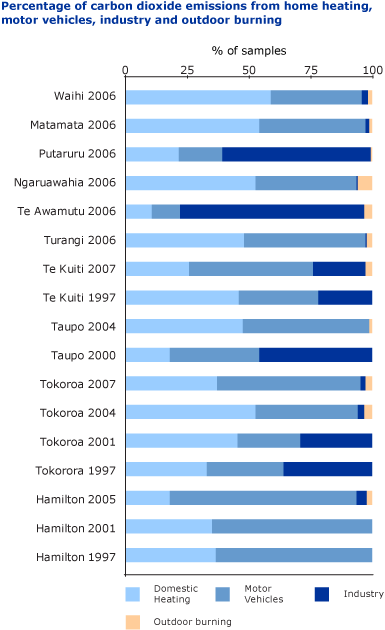Monitoring sites
The amounts of carbon dioxide being produced by motor vehicles, industry and home heating were been estimated for:
- Hamilton
- Tokoroa
- Te Kūiti
- Taupō.
In addition, the amounts of carbon dioxide being produced by home heating were estimated for:
- Huntly
- Matamata
- Putaruru.
Monitoring frequency
Emission summaries were completed for Hamilton, Tokoroa, Taupō and Te Kūiti every three to five years.
Monitoring history
The following table lists the years in which each town’s emission inventories were compiled.
| Town |
Emission inventory
|
| |
Domestic heating |
Motor vehicles |
Industry |
| Hamilton |
1997, 2001, 2005 |
1997, 2001, 2005 |
1997, 2005 |
| Tokoroa |
1997, 2001, 2004, 2007 |
1997, 2004, 2007 |
1997, 2004, 2007 |
| Taupō |
2000, 2004 |
2000, 2004 |
1997, 2004 |
| Te Kūiti, |
1997, 2001, 2007 |
1997, 2007 |
1997, 2007 |
| Putaruru |
2006 |
2006 |
2006 |
| Matamata |
2006 |
2006 |
2006 |
| Waihi |
2006 |
2007 |
2006 |
| Te Awamutu |
2006 |
2006 |
2007 |
| Ngāruawāhia |
2006 |
2006 |
2006 |
| Turangi |
2006 |
2006 |
2006 |
Measurement techniques
Home heating
We estimated the amount of air emissions coming from home heating using household surveys. We asked people what they use to heat their home and the quantity and type of fuel they use, for example, gas or wood. We used this information to:
- estimate the amount of fuel used by different home heating appliances. For example, an open fire may burn about 20 kilograms of wood per day.
- estimate the amount of emissions given off by different home heating appliances and different types of fuel. For example, open fires emit about 1,600 grams of CO2 per kilogramof wood burned.
- estimate CO2 emission rates, as grams of CO2 per kilogram of fuel burnt (g/kg). For example, a household burning 20 kilograms of wood per day on an open fire emits around 32,000 grams of CO2 a day, based on an emission rate of 1,600 g/kg for an open fire.
Motor vehicle emissions
We used information from area-specific ‘local road network models’ to estimate the number and types of vehicles travelling in an area. Using the Ministry of Transport’s data for average vehicle emission rates, we estimated the amount of emissions coming from motor vehicles in a given area.
Industrial emissions
We used the information contained in resource consent files at Waikato Regional Council to estimate emissions from industry. Emission estimates were calculated based on daily fuel use or activity and the use of either average industrial emission rates for that process type or emission-specific information for the site. Where there was no New Zealand specific data, we use average emission rates from the United States.




To ask for help or report a problem, contact us
Tell us how we can improve the information on this page. (optional)